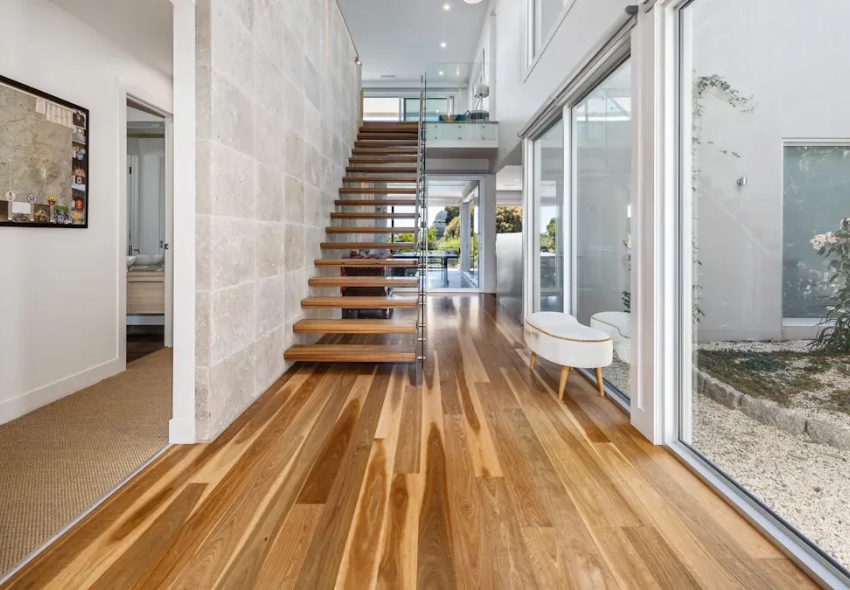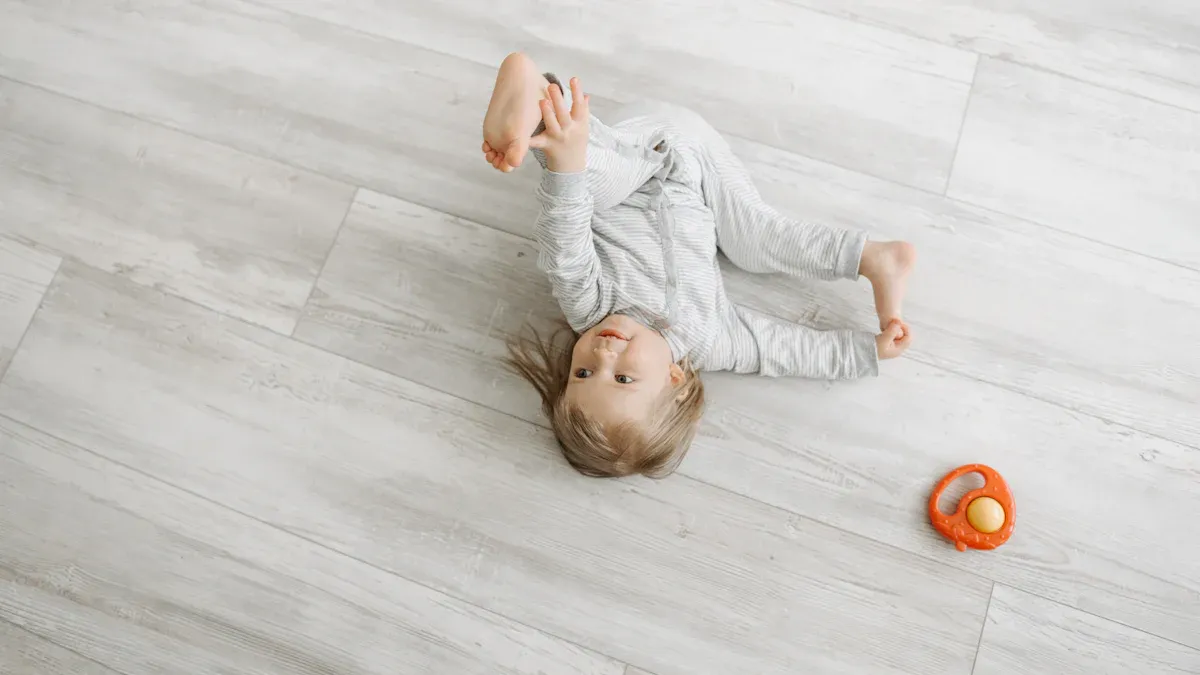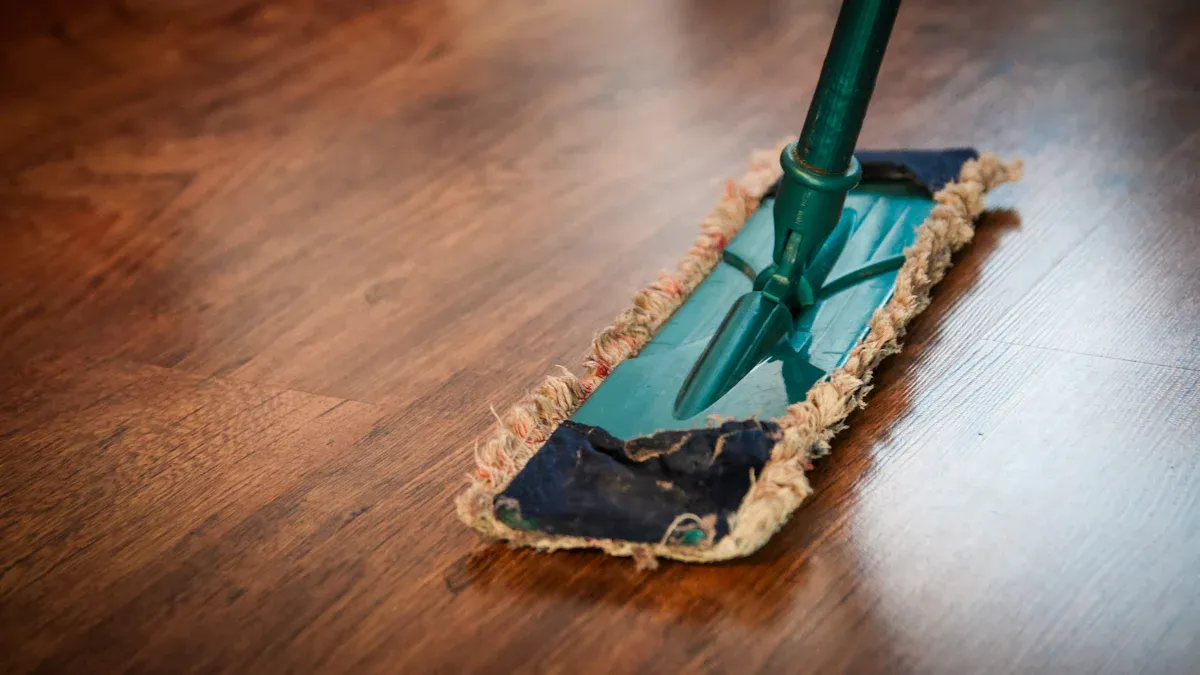
You might wonder why 8mm click flooring stands out. This flooring gives you a smart mix of strength, comfort, and quick installation. The thickness matters—it helps with how the flooring feels and lasts. The click-lock system makes things easy. Think about your space and the benefits you want from your flooring.

8mm click flooring is strong and comfy. It is easy to put in. The click-lock system is simple to use. You do not need glue or nails for it.
This flooring is tough and feels nice. It works well in most rooms at home. It is best to use good underlayment. Careful installation helps it last longer.
Clean your floor often to keep it nice. Simple care makes it last longer. This protects it from scratches and water. It also stops damage and wear.
When you look for new flooring, you might see the term 8mm click flooring. This type of flooring uses planks that are 8 millimeters thick. The "click" part means the planks snap together with a special locking system. You do not need glue or nails. You just line up the edges and press down. The planks lock in place with a simple click.
You can find 8mm click flooring in two main types: laminate and vinyl. If you choose 8mm laminate flooring, you get planks made from wood-based materials. Most use high-density fiberboard or composite wood at the core. The top layer has a finished surface that looks like wood or stone. Vinyl 8mm click flooring often uses a stone plastic composite (SPC) core. This core mixes stone and plastic polymers. It makes the flooring rigid and waterproof. Both types give you a strong floor that looks great in any room.
You might wonder about finishes and textures. There are many choices. Some floors look shiny and smooth. Others have a matte or rustic look. You can even find planks that feel like real wood under your feet.
Here is a quick look at the most popular finishes and textures you can choose:
Finish/Texture Type | Description/Example |
|---|---|
High Gloss | Shiny, reflective surface |
Smooth | Sleek, even feel |
Matte | Soft, non-reflective finish |
Distressed Look | Worn, rustic appearance |
Handscraped | Mimics hand-scraped wood |
Textured | Tactile surface finishes |
Low Gloss | Less shine, subtle look |
Wire Brushed | Highlights wood grain |
Traditional | Classic finish style |
Unfinished | Ready for custom finishing |
Modern | Contemporary style |
You get many benefits when you choose 8mm click flooring. The 8mm thickness gives your floor more stability and a solid feel. Thicker planks last longer than thinner ones. If you compare 8mm laminate flooring to 6mm or 7mm options, you will notice the difference in strength and comfort. The best thickness for laminate flooring often depends on your needs, but 8mm is a popular choice for many homes.
Here are some key features that make 8mm click flooring stand out:
The 8mm thickness adds stability and helps your floor last longer.
You get better durability and a firmer feel underfoot, which is great for busy rooms.
The click-lock system makes installation simple. You do not need glue or nails.
This flooring works best for permanent setups. If you take it apart and put it back together too often, the locking system can wear out.
8mm click flooring is known for its easy floating installation. You can lay it over most subfloors.
You might also think about sound. Thicker laminate flooring reduces noise better than thin planks. 8mm laminate flooring gives you moderate sound insulation. It works well in bedrooms or areas with low to medium foot traffic. If you want even less noise, you can add an underlayment or choose thicker planks.
Note: The advantages of thicker laminate flooring include more comfort, better sound control, and longer life. You get more longevity with thicker laminate flooring, so your floor stays looking good for years.
If you want a floor that is easy to install, feels solid, and comes in many styles, 8mm click flooring is a great choice for your home.

When you pick 8mm click flooring, you want it to last. This type of laminate flooring gives you a good mix of durability and comfort for most homes. You can use it in bedrooms, living rooms, and even some high-traffic areas. The 8mm thickness helps the flooring handle daily wear and tear. It stands up to kids, pets, and busy family life.
8mm laminate flooring works well in homes and rental spaces. It balances stability, durability, and easy installation.
Thicker laminate, like 10mm or 12mm, is best for very high-traffic areas or commercial spaces. These options cost more but offer extra durability and sound insulation.
Thinner laminate, such as 6mm, may not last as long in high-traffic areas. It can show damage faster and does not hide subfloor bumps as well.
The AC rating matters too. A higher AC rating means better durability, not just thickness alone.
Quality underlayment and good installation help your flooring last longer.
If you want flooring that handles most daily foot traffic and offers good longevity, 8mm laminate is a smart choice.
Comfort matters when you walk on your flooring every day. 8mm laminate flooring feels solid and steady under your feet. The thickness gives you a cushioned feel, which makes standing or walking for long periods easier.
Underlayment adds a soft layer under the laminate. It absorbs sound and keeps your space quieter.
The backing layer helps with thermal insulation. Your flooring feels warmer in winter and cooler in summer.
8mm laminate flooring covers small bumps in the subfloor, so you get a smooth, even surface.
The strong core and secure joins keep the flooring stable. You will not feel shifting or bouncing as you walk.
You get both comfort and durability with 8mm laminate flooring. This balance helps your floor look and feel great for years, giving you the longevity you want in your home.
You may ask how 8mm laminate flooring compares to vinyl flooring. Both look nice and are easy to put in. But they are different in some ways. Laminate flooring has a strong core and a hard top layer. Vinyl flooring, like luxury vinyl plank (LVP), has a waterproof core and a tough surface.
Here is a simple chart to show the differences:
Durability Aspect | 8mm Laminate Flooring | Luxury Vinyl Plank (LVP) Flooring |
|---|---|---|
Wear & Scratch Resistance | Hard top layer and strong core; resists dents and scratches; lasts up to 25 years if cared for; cannot be fixed if damaged. | Tough surface layer; can get scratches and dents more easily; thick wear layers on good LVP help stop scratches; can last over 20 years. |
Moisture Resistance | Can be hurt by water; regular laminate only handles small spills; some types resist water but are not as waterproof as vinyl. | Fully waterproof; great for wet places like kitchens and bathrooms; does not swell, peel, or warp. |
Maintenance | Needs gentle cleaning with a damp mop; clean up spills fast to avoid damage. | Easier to clean; can use a wet mop; stain-resistant surface makes cleaning simple. |
Laminate flooring feels solid and does not scratch easily. Vinyl flooring is best if you need waterproof floors. Vinyl is also easier to clean.
Let’s look at cost and how you install them:
Aspect | 8mm Laminate Flooring | Vinyl Flooring (including LVP) |
|---|---|---|
Upfront Material Cost | Usually costs less at first | Costs more, especially for luxury vinyl planks (LVP) |
Durability & Water Resistance | Not as water resistant, may need more care | Very water resistant and tough, may save money later |
Installation | Click-lock system is easy for DIY; saves money | Sheet vinyl may need a pro; LVP can be DIY-friendly |
Additional Costs | Needs underlayment for sound and moisture | Often no underlayment needed but needs a good subfloor |
Long-term Value | Costs less at first but may need repairs | Costs more at first but lasts longer and needs fewer fixes |
Tip: If you want a strong floor that does not cost much, laminate flooring is a good choice. For rooms with water, like bathrooms or kitchens, vinyl flooring is safer.
There are more choices than just laminate or vinyl. Hybrid flooring mixes the best parts of both. It has a strong core like vinyl and a hard top like laminate. Hybrid flooring works well in wet and busy rooms.
Engineered flooring is another choice. It has a real wood top layer and a stable core. It looks like hardwood but is stronger. Engineered flooring costs more than laminate. But it adds style and value to your home.
Hybrid flooring is good for busy homes and wet rooms.
Engineered flooring gives you real wood looks and feel.
You can pick the best flooring for each room. Think about what you need, your budget, and the style you want. Laminate, vinyl, hybrid, and engineered flooring all have good things to offer.

Getting ready for your 8mm click flooring installation can make the whole project smoother. You want your new laminate floor to look great and last a long time. Here’s how you can set yourself up for success:
Clear the Room: Move all furniture and rugs out of the way. You need a clean, open space to work.
Check the Subfloor: Make sure the subfloor is clean, dry, and flat. Sweep or vacuum away dust and dirt. If you see bumps or dips, fix them before you start. Uneven subfloors can cause your laminate flooring to shift or wear out faster.
Measure Carefully: Measure your room more than once. Plan how the planks will fit. Don’t forget to leave expansion gaps around the edges. These gaps let the flooring expand and contract with changes in temperature and humidity.
Gather the Right Tools: You’ll need spacers, a tapping block, a saw (like a jigsaw), and a measuring tape. Having the right tools makes the installation process much easier.
Let the Planks Acclimate: Place the unopened boxes of laminate flooring in the room for at least 48 hours. This helps the planks adjust to the room’s temperature and humidity.
Read the Instructions: Always check the manufacturer’s guidelines. Each brand may have special steps for the installation process.
Tip: Skipping these steps can lead to problems like buckling, gaps, or damage. Take your time with prep work. It pays off!
Common mistakes to avoid:
Not making sure the subfloor is clean, dry, and flat.
Forgetting to measure the room or skipping expansion gaps.
Using the wrong tools or missing materials.
Skipping the acclimatization step.
Ignoring the manufacturer’s instructions.
Not leaving enough space around the edges for expansion.
Choosing the right underlayment is a big part of a successful laminate flooring installation. Underlayment sits between your subfloor and the laminate planks. It helps with comfort, sound, and moisture protection. The type you pick depends on your subfloor and where you plan to install the flooring.
Environment / Subfloor Type | Recommended Underlayment Type | Key Characteristics and Notes |
|---|---|---|
Concrete Subfloor | Combination foam with vapor barrier | Blocks moisture; good for basements and bathrooms |
Plywood/OSB Subfloor (Dry) | Standard foam underlayment | Lets wood breathe; not for wet areas |
Plywood/OSB Subfloor (Moist areas) | Combination foam with vapor barrier | Stops moisture buildup; prevents mold and warping |
Any Subfloor (for noise reduction) | Cork underlayment (over a plastic moisture barrier in damp areas) | Reduces noise; antimicrobial; not moisture-proof alone |
Keep underlayment between 3mm and 6mm thick. Thicker or softer underlayments can make the laminate click system unstable.
Some laminate flooring comes with underlayment already attached. If yours does, you may not need a separate layer.
Basic foam underlayment works best with 8mm laminate flooring. Upgraded foam with vapor barriers, cork, or rubber underlayments are not always compatible with 8mm planks.
Note: The right underlayment protects your floor and makes it more comfortable. It also helps your laminate flooring last longer.
Now you’re ready for the main event—the installation process! Here’s a simple step-by-step guide to help you lay your 8mm click flooring like a pro:
Lay the Underlayment: Roll out your chosen underlayment. Make sure it covers the whole floor. Overlap the edges if needed, but don’t double up layers.
Plan Your Layout: Start along the longest wall. Place spacers between the wall and the first row of planks to keep an expansion gap.
Install the First Row: Lay the first plank with the tongue side facing the wall. Connect the next plank by angling and clicking it into place. Continue until you finish the row.
Stagger the Joints: Start the next row with a plank cut to a different length. This makes the joints look better and adds strength.
Click and Lock: Angle each new plank into the previous row and press down until you hear a click. Use a tapping block if needed to make sure the seams are tight.
Cut Planks as Needed: Use a jigsaw or laminate cutter to trim planks for the end of each row or around obstacles.
Finish the Last Row: You may need to cut the planks lengthwise to fit. Don’t forget to keep the expansion gap.
Remove Spacers and Add Trim: Once all planks are in place, take out the spacers. Install baseboards or quarter-round molding to cover the gaps.
DIY Tip: Take your time and check each row as you go. If you’re not sure about a step, ask a professional or watch a video for help.
Professional installation can save you time and stress, especially in tricky rooms or large spaces. But if you follow these steps and avoid common mistakes, you can handle the installation process yourself.
Remember: The right preparation, underlayment, and careful installation process help your laminate flooring look great and last for years.
Keeping your 8mm click laminate flooring clean is important. It helps your floor look nice and last longer. You do not need special tools or strong cleaners. A simple cleaning routine works best. Here are some easy steps:
Sweep or vacuum every day with a soft broom or a vacuum for hard floors. This stops dirt and grit from scratching your floor.
Use a damp microfiber mop and a gentle cleaner. Make sure your mop is not too wet. Do not leave water on the floor.
Wipe up spills as soon as they happen. Water can hurt laminate if it stays too long.
Deep clean your floor once a month or every two months. Use gentle cleaning methods and do not use a steam mop. Too much water can damage your floor.
You want your laminate flooring to look good for a long time. Some simple habits can help you avoid problems. Try these tips:
Put felt pads under furniture legs. This helps stop scratches and dents.
Place doormats at every door. Mats catch dirt and water before they get on your floor.
Never drag heavy furniture across the floor. Lift things or use sliders to move them.
Keep the air in your home at a steady level. Laminate can change shape if the air is too dry or too wet.
Use rugs in busy areas to help your floor last longer.
Make sure your floor was put in with the right underlayment and tools.
Here is a quick chart that shows what can damage laminate flooring in homes:
Damage Type | Common Causes | Who Is Responsible? |
|---|---|---|
Indentation Damage | Dropping heavy things | You or installer |
Scratches and Scuffs | Toys, dragging furniture, dirt | You or installer |
Water Damage | Leaks, spills, missing vapor barrier | You or installer |
Manufacturing Defects | Problems from the factory | Manufacturer or installer |
Installation Errors | Bad joins, missing underlay | Installer |
Environmental Factors | Wet subfloors, not letting planks adjust | You or installer |
Note: Taking care of your floor is easy. Good cleaning and smart habits keep your laminate looking nice.
You get a floor that’s easy to install, feels solid, and lasts. Most customers rate 8mm click flooring 4.8 out of 5. Before you choose, think about your room’s traffic, subfloor, and budget. If you want comfort and value, 8mm click flooring could be your best fit!
You can use it in bathrooms, but only if you pick a waterproof type. Always check the product label before you buy.
No glue needed! The click-lock system lets you snap the planks together. You just lay them down and press until they click.
You can remove the damaged plank by unlocking the floor from the nearest wall. Replace it with a new one, then click everything back in place.